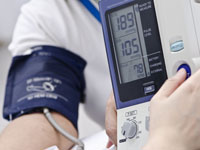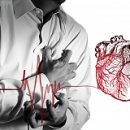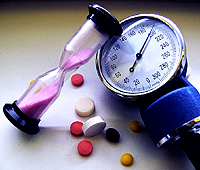Cleaning arrhythmia - the most common violation of the heart rhythm, which in itself does not threaten the life of a person. Why then doctors beat the alarm when identifying flickering arrhythmia? Answer - in the article.
Content
 Cleaning arrhythmia — The most common heart rate disruption, which in itself does not represent danger to human life. Frequent, following each other without a break of the reduction of two upper heart chambers, that is, atrium, little affect the general blood circulation. The ventricles continue to be reduced in the usual mode and pump blood according to vessels, delivering oxygen and nutrients in all corners of the body. Violation of the atrial reducing rhythm extremely rarely leads to a failure in the work of the ventricles, which actually represents the greatest threat to life. Why then then flickering arrhythmia attracts so close attention of doctors? What is her danger to man?
Cleaning arrhythmia — The most common heart rate disruption, which in itself does not represent danger to human life. Frequent, following each other without a break of the reduction of two upper heart chambers, that is, atrium, little affect the general blood circulation. The ventricles continue to be reduced in the usual mode and pump blood according to vessels, delivering oxygen and nutrients in all corners of the body. Violation of the atrial reducing rhythm extremely rarely leads to a failure in the work of the ventricles, which actually represents the greatest threat to life. Why then then flickering arrhythmia attracts so close attention of doctors? What is her danger to man?
What shimmeries and why?
Cleaning arrhythmia or, as it is also called, atrial fibrillation is characterized by a frequent chaotic reduction in atria, reaching frequency of 350-700 beats per minute. In essence, the two upper hearts, feeding blood in the ventricles, cease to decrease, only twitching individual fibers of the heart muscle are noted. Blood enters the ventricles «Self», And the ventricles continue to work in their rhythm, compressing much less often than the atrium.
Causes of flickering arrhythmias lie in the defects of the driver's driver's work responsible for the agreed reduction of the heart departments, in violation of the conductivity of the fibers delivering the nerve impulses from the rhythm driver to myocardium, in increasing the excitability of the heart muscle, responding with a reduction in these impulses. All this is quite difficult for an ordinary person, it is more important to know that stress, smoking, alcohol intake and abuse of caffeine can be brought to the violation of the heart rhythm. Even a banal viral infection can cause heart failures, not to mention hypertensive disease, heart disease, lungs and thyroid glands.
Why treat arrhythmia?
Each 200th resident of the Earth suffers flicker arrhythmia, and the older man, the higher the risk of developing arrhythmia. In people aged 50-60 years old, the flickering arrhythmia occurs with a frequency of 3.5%, and among 80-90 summer old people, rhythm has almost every tenth. Interestingly, women suffer from arrhythmia less often men, but they have a violation of the rhythm proceeds harder and difficult to correction.
Cleaning arrhythmia, although it does not threaten a person's life directly, significantly reduces the quality of life. Just look at her symptoms to make sure — life with arrhythmia is not sugar. «Inaction» Atriality leads to the fact that there are little blood in the ventricles, which means that the general blood circulation suffers and the work of the whole organism is disturbed.
The most distinct symptoms of flickering arrhythmia:
- heart palpitations;
- Pain in the chest;
- general weakness;
- dizziness or faint condition;
- sweating;
- feeling of lack of air;
- panic fear for their own life;
- Student urination.
Attacks of flickering arrhythmia can be rare or frequent, sometimes the rhythm disorders are constant and then they must be treated.
Than dangerous flickering arrhythmia?
In half cases, flickering arrhythmia does not violate the overall state of patients, the attacks remain unnoticed, but this does not diminish the dangers of the disease. The thing is that the lack of a coherent reduction of atria leads to stagnation in them and is fraught with the formation of blood clots — Thrombov. From the atria blood clots fall into the ventricles, then entered in the artery of the brain and other vital organs, causing acute circulatory disruption.
- Cleaning arrhythmia is considered one of the main causes of brain strokes. It is believed that the presence of this heart rate impairment increases 5 times increases the risk of brain catastrophe ending in death or disabilities.
- Finding into the system of coronary arteries, thrombus causes the development of myocardial infarction.
- Once in the circulatory vessels of the intestines, the thrombus becomes the cause of its gangrene and the development of the hardest peritonitis, often having a deadly outcome.
Doctors believe that it is enough for the development of severe complications that the attack of flickering arrhythmia continued for 2 days. At the same time, according to statistics, up to 30% of asymptomatic attacks last much longer. That's the main threat to the heart rate disorders of the heart rhythm itself.









